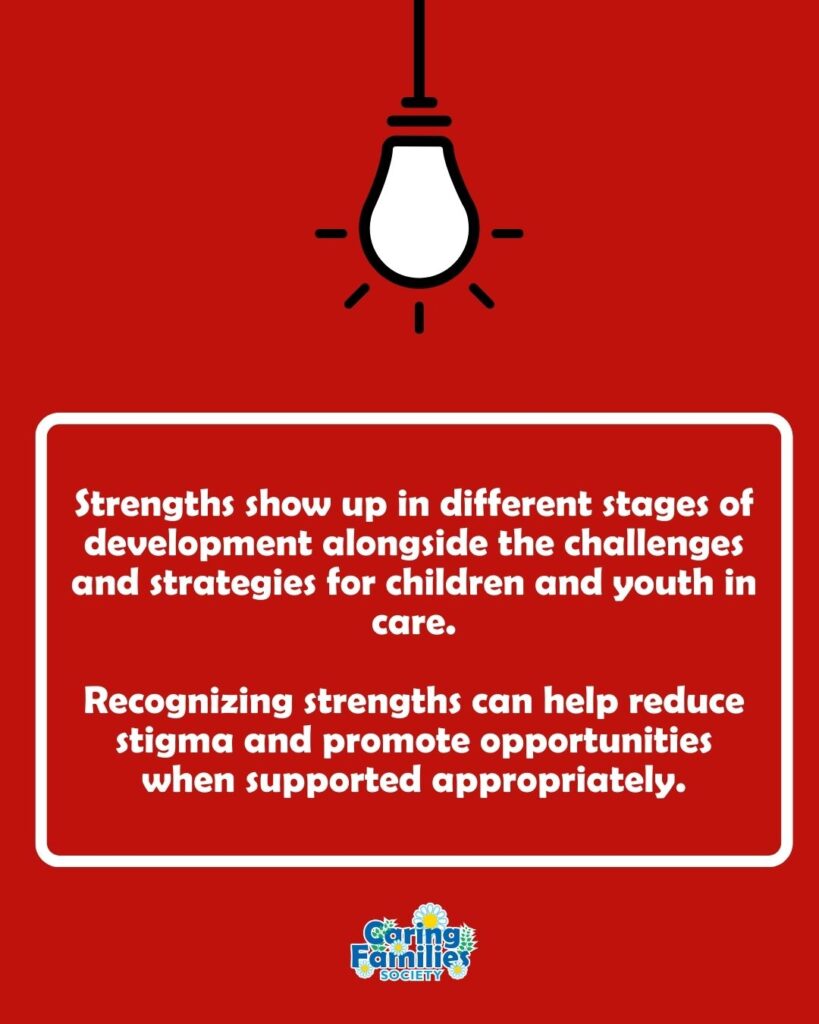By Janet Christie, Parent of a Young Adult with FASD, and former FASD Key Worker
Fetal Alcohol Spectrum Disorder (FASD) is a diagnostic term used to describe the impacts on the brain and body of individuals prenatally exposed to alcohol. FASD is a lifelong disability, and individuals usually experience challenges in their daily lives.
The reality is that FASD affects every stage of development—from infancy through adulthood. For caregivers, a common question is: “What will this look like as my child grows older?” Understanding how FASD changes across the lifespan helps caregivers adjust expectations, provide the right supports, and plan for the future.
Lifelong Nature of FASD
The impacts of FASD are lifelong and evolve as individuals progress through different life stages.
- Primary impacts do not diminish with age; they require ongoing support.
- Early and appropriate interventions can positively influence long-term outcomes.
- Understanding the lifelong nature of FASD is essential for caregivers and service providers.
Primary Impacts
Primary disabilities are those caused directly by prenatal alcohol exposure and are permanent. No two individuals experience them in the same way, but common challenges include:
- Cognitive differences (thinking and learning).
- Behavioural differences (actions and self-control).
- Physical differences (body and health).
- Sensory differences (processing information from the senses). (Saskatchewan FASD Network)
As a result, individuals with FASD may struggle with abstract reasoning, organization, planning, memory, connecting cause and effect, dysmaturity, and regulating their behaviours and emotions.
Adverse Outcomes in FASD
Adverse outcomes often cause more stress than the primary disabilities themselves. These difficulties are not directly caused by prenatal alcohol exposure, but develop when a person’s needs are misunderstood or unsupported. The mismatch between abilities and expectations can lead to repeated frustration and failure.
Caregivers can reduce risks by creating environments that fit the individual’s needs. A good fit is built on recognizing both strengths and struggles, while providing opportunities to discover talents and build abilities. This strength-based approach lessens challenges and helps individuals with FASD thrive.

Recognizing Strengths
While much of the focus is often on the challenges linked to FASD, it is just as important to recognize the many strengths these individuals bring. Children, youth, and adults with FASD are often warm, funny, resilient, creative, and bring a unique perspective to life. These strengths not only balance the difficulties but also provide powerful opportunities to build confidence, connection, and success.
Throughout this blog, we’ll look at how strengths show up in different stages of development alongside the challenges and strategies. Recognizing strengths can help reduce stigma and promote opportunities when supported appropriately.
Early Childhood (0–6 years)
In the earliest years, children with FASD may show differences in development. Some may reach milestones later, while others meet them on time but struggle with regulation and sensory input.
Common Characteristics
- Physical differences: Low birth weight, growth delays, and sometimes distinct facial features or organ issues (heart, kidneys, hearing, vision).
- Developmental delays: Slower development in milestones such as walking, talking, or using sentences.
- Sensory processing challenges: Over- or under-reactivity to touch, sound, light, or other sensory input.
- Sleep and feeding difficulties: Poor sleep/wake cycles, sucking or feeding problems in infancy.
- Motor delays: Problems with balance, coordination, or fine motor skills.
- Executive functioning challenges: Struggles with self-regulation, attention, and adapting to change.
- Behavioural and social challenges: Fussiness, difficulty soothing, and emotional regulation difficulties.

Caregiver Focus
- Build predictable routines: Consistency reduces anxiety and helps children feel secure.
- Support learning through play: Use songs, visual cues, and play-based approaches to teach skills.
- Seek early interventions: Speech therapy, occupational therapy, physical therapy, and play-based programs can address delays.
- Encourage attachment: Prioritize bonding and trust-building through nurturing interactions.
- Recognize sensory needs: Provide calming spaces, weighted blankets, or quiet time to reduce overload.
- Monitor sleep and feeding: Work with healthcare providers to address persistent difficulties.
- Pursue early diagnosis: Assessment of motor, sensory, and language skills can help secure supports.
- Create a stable home environment: Loving, safe, and predictable settings promote resilience and growth.
Common Strengths
- Friendly, engaging, and outgoing.
- Affectionate and loving.
- Likeable and eager to please.
- Curious, innocent, and straightforward.
- Funny, playful, and full of energy.
- Bring joy and warmth to family and caregivers.
- Show strong connections with animals and younger children.
Specific Ideas for Infants (SNAP, 1999)
- Feed in a quiet, darkened room to reduce stimulation.
- Wrap in a blanket for comfort during feeding.
- Gently press the chin upward in rhythm while feeding.
- Stroke lips and gums before breastfeeding or bottle-feeding.
- Experiment with different bottle nipples if needed.
As children move into school age, the gap between what they seem to know and what they can consistently do often becomes more visible.
School Age (7–12 years)
When school begins, children with FASD often face increased demands—and their challenges may become more noticeable. While intelligence may be average or above, difficulties with memory, comprehension, and transitions can create gaps between what they “know” and what they can do.
Common Characteristics
- Cognitive challenges: Difficulty with attention, memory, problem-solving, and abstract concepts like math or time.
- Behavioural challenges: Poor impulse control, frustration when misunderstood, and difficulty managing emotions.
- Dysmaturity: Functioning at a much younger developmental level than chronological age.
- Memory and generalization: Forgetting instructions or lessons from one day to the next; struggling to apply skills in new contexts.
- Transition challenges: Difficulty coping with changes in routines, activities, or environments.
- Social challenges: Trouble forming and maintaining friendships with same-age peers.

Caregiver Focus
- Advocate in education: Request IEPs, classroom accommodations, and teacher awareness of FASD.
- Reinforce learning at home: Use visual aids, checklists, repetition, and step-by-step teaching.
- Teach adaptive skills explicitly: Hygiene, money management, and safety require direct instruction.
- Use concrete examples: Replace abstract ideas with visual, hands-on tools (e.g., clocks with movable hands).
- Support social connections: Facilitate structured activities with adult guidance to build friendships.
- Help with transitions: Prepare for changes in routine with advance warnings and visual schedules.
- Break tasks into smaller steps: Offer frequent breaks and praise persistence, not just results.
- Provide safe outlets for frustration: Create calming strategies such as quiet corners, movement breaks, or stress tools.
- Model social skills: Practice turn-taking, sharing, and conflict resolution through guided play.
Common Strengths
- Verbal, often great storytellers.
- Willing, helpful, and generous.
- Creative, artistic, or musical.
- Athletic and energetic.
- Hands-on learners who excel outside traditional classrooms.
- Determined and persistent.
- Compassionate and non-judgmental toward peers.
- Curious and bring unique perspectives.
As children grow into adolescence, the desire for independence often collides with ongoing developmental needs, creating new risks and opportunities.
Adolescence (13–18 years)
Adolescence can be especially challenging for youth with FASD. As expectations for independence grow, the gap between chronological age and developmental ability may widen. Impulsivity, poor judgment, and vulnerability to peer influence can increase risks. At the same time, many teens with FASD want to fit in with peers but may struggle socially.
Common Characteristics
- Impulse control challenges: Acting before thinking, poor judgment, and lack of awareness of consequences.
- Peer vulnerability: Increased susceptibility to bullying, manipulation, or risky peer groups.
- Emotional regulation difficulties: Struggles with frustration, anxiety, depression, or anger.
- Relationship risks: Higher risk of unsafe or unhealthy relationships.
- Academic and adaptive gaps: Schoolwork and responsibilities often exceed ability, leading to stress or disengagement.
- Identity and self-esteem challenges: Desire for independence but ongoing reliance on caregivers, creating feelings of shame or failure.

Caregiver Focus
- Maintain supervision: Even if teens appear independent, skills often lag behind.
- Guide safe decision-making: Use role-play, social stories, and structured practice for choices and consequences.
- Support peer relationships: Monitor friendships, set boundaries for online safety, and encourage positive peer groups.
- Provide structure and predictability: Routines help manage impulsivity and reduce anxiety.
- Address emotional health: Collaborate with mental health professionals to support anxiety, depression, or risk-taking.
- Offer safe outlets for expression: Encourage sports, art, music, or mentorship to build confidence and belonging.
- Teach life skills gradually: Introduce cooking, budgeting, and transportation step by step with repetition.
- Align expectations with developmental age: Avoid frustration by matching responsibilities to ability.
- Celebrate achievements: Recognize effort and resilience to strengthen self-worth.
- Keep communication open: Listen without judgment and validate feelings to maintain trust.
Common Strengths
- Social, engaging, and funny—often the life of the group.
- Insightful and bright in areas of interest.
- Mechanical or technical talents may emerge.
- Creative problem-solvers with the right support.
- Forgiving and non-judgmental in relationships.
- Determined and resilient despite challenges.
- Compassionate, especially toward younger children and animals.
- Straightforward and honest.
- Thrive in structured, supportive environments.
As teens transition into adulthood, the risks of adverse outcomes increase—but so do opportunities for independence, self-advocacy, and thriving with the right supports.
Young Adulthood (19+ years)
While the challenges of FASD begin with brain-based differences, many of the hardest struggles in later childhood, adolescence, and adulthood come from adverse outcomes—such as school disruptions, mental health concerns, or difficulties living independently. The key to reducing risks and supporting growth is finding a good fit: an environment that builds on strengths, accommodates struggles, and provides opportunities to thrive.
Common Characteristics
- Adverse outcomes: Risks of mental health problems, addictions, justice involvement, or housing instability due to repeated mismatch between abilities and demands.
- Employment challenges: Difficulty keeping jobs, following schedules, or meeting workplace expectations.
- Money management difficulties: Trouble budgeting, paying bills, or avoiding financial exploitation.
- Housing instability: Challenges with maintaining safe and consistent living arrangements.
- Vulnerability to exploitation: Ongoing susceptibility to unsafe relationships or manipulation.
- Social isolation: Risk of loneliness, withdrawal, or reliance on unsafe peer groups.

Caregiver Focus
- Plan early and individually: Begin transition planning before 18, building on strengths and addressing struggles in work, living, and daily skills.
- Maintain structure and predictability: Use routines, reminders, and consistent expectations to reduce anxiety and increase stability.
- Teach life skills step by step: Provide explicit instruction in budgeting, banking, time management, cooking, and transportation, with repetition and hands-on practice.
- Offer ongoing supervision: Continue oversight in finances, healthcare, and housing—even when independence appears possible.
- Provide real-world practice: Encourage volunteer work, internships, or mock interviews to prepare for adult responsibilities.
- Build strong networks: Connect with disability services, advocacy groups, mentors, and community programs for long-term stability.
- Promote safe independence: Support employment, housing, and social activities that allow for growth within safe boundaries.
- Foster self-advocacy: Help young adults communicate their needs and make informed choices.
- Address sensitive topics openly: Offer non-judgmental guidance on sexuality, relationships, and substance use.
- Support mental health proactively: Work with professionals to address anxiety, depression, or addiction concerns.
- Celebrate strengths: Encourage roles in creative, caregiving, or hands-on fields (e.g., art, trades, working with animals, peer mentoring).
Common Strengths
- Persistent and hard-working when tasks align with interests.
- Caring, compassionate, and loyal in relationships.
- Good with children, mentoring, or caregiving.
- Resilient and able to bounce back from setbacks.
- Excel in hands-on, creative, or structured roles (art, trades, caregiving, animals).
- Honest, straightforward, funny, and engaging.
- Bring unique perspectives and generosity to community life.
The Caregiver’s Role Across the Lifespan
Caregivers are the steady anchor in the lives of children, youth, and adults with FASD. The role shifts over time—from meeting basic needs in early childhood to navigating schools, healthcare, and eventually adult services.
One of the most important lessons is to set expectations based on developmental age, not chronological age. A teenager may need the same support as a much younger child, and that’s okay. Recognizing this reduces frustration for both caregiver and child.
Self-care for caregivers is also essential. The journey is lifelong, and sustaining it requires community support, respite, and ongoing learning.
By understanding FASD across the lifespan, caregivers can adapt their approach at every stage, creating environments where individuals not only cope but truly thrive.

Read more in this series:
FASD and the Education System in BC: A Foster Caregiver’s Guide
FASD Awareness Day: Why Talking About Drinking During Pregnancy Matters
FASD: A Whole-Body Condition Every Foster Caregiver Should Understand

